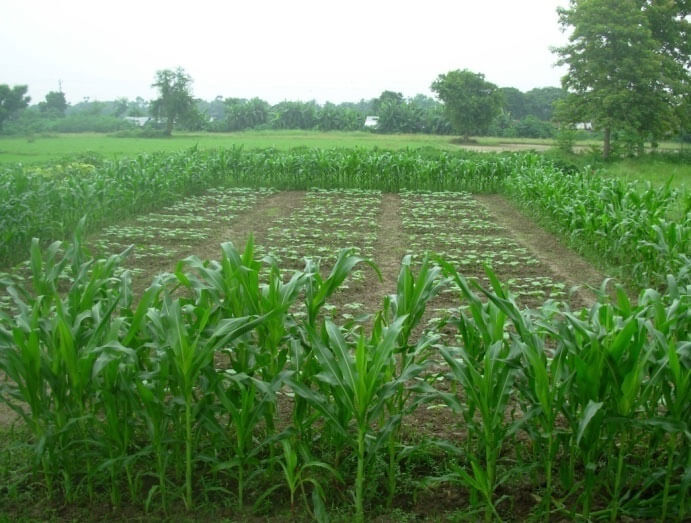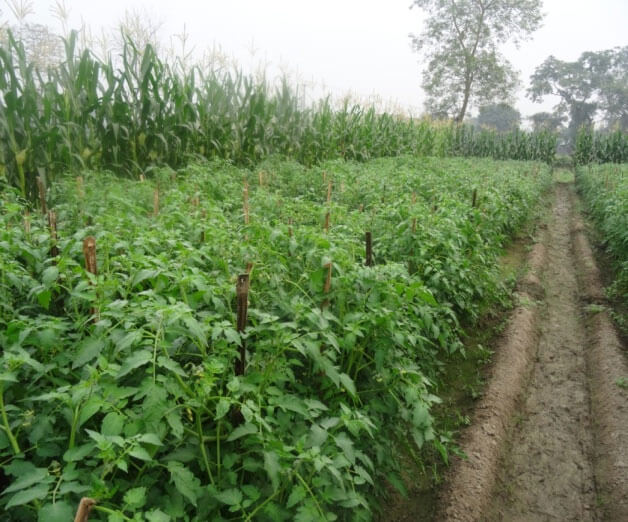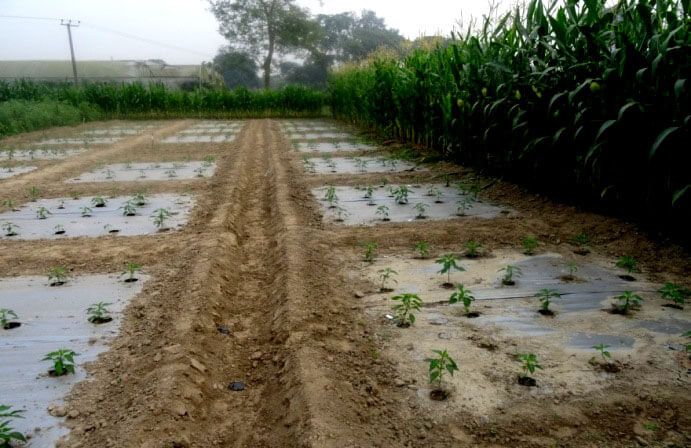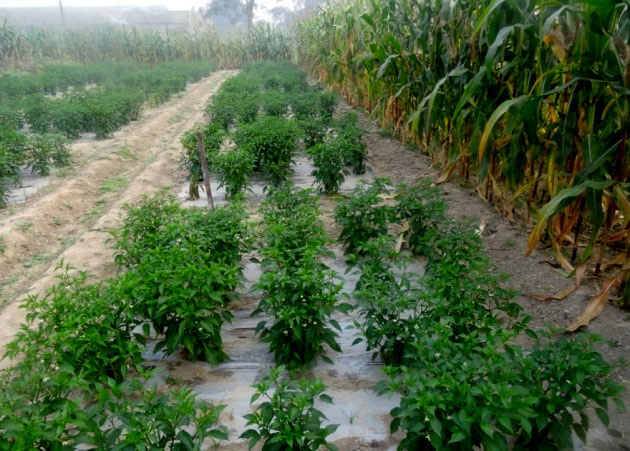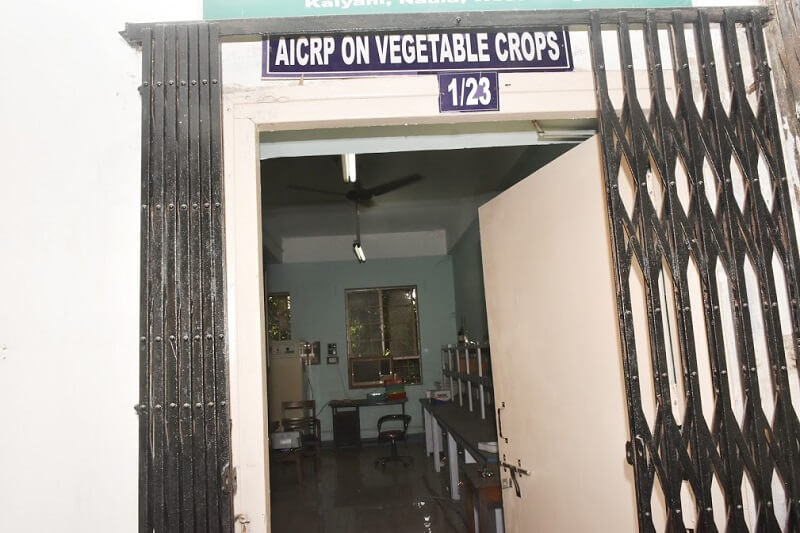AICRP on Vegetable Crops
West Bengal is the leading vegetable growing state in India, covering an area of about 13.80 lakh hectares with an annual production of 255.00 lakh tones including potato having the productivity of 18.47 t/ha (NHB, 2016-2017). Diverse agro-climatic regions, wide variety of soils supplemented with substantial rainfall has made the state a forerunner in this sector. About 14 % of the sown land under vegetable crops excluding potato, the highest in the country, is the testimony that vegetable farming stands as dependable livelihood security to the small and marginal farmers of West Bengal. Agri-Export Zones (AEZ) redefines Indian Agriculture through an integrated and focused approach. The Central Government has so far sanctioned one AEZ for vegetables in West Bengal covering three districts viz., Nadia, Murshidabad and North 24 Parganas. This covers a major part of the Gangetic alluvium with high cropping intensity resulting in round the year availability for a number of vegetable crops. Creation of AEZ has brought about a paradigm shift in the approach-from “production oriented” to “market driven” vegetable farming. The state, at present, is the leading producer of brinjal (28.5%), cabbage (34.3%), cauliflower (29%) and okra (19.4%). Concerted research efforts in the erstwhile Department of Horticulture (now Department of Vegetable Science, Faculty of Horticulture) and All India Coordinated Research Project on Vegetable Crops, Kalyani centre, Bidhan Chandra Krishi Viswavidyalaya have contributed immensely to the development of vegetable production scenario of the state. Obviously large pool of skilled and enthusiastic small and marginal farmers is mainly responsible to bring about revolution in vegetable production in the state.
Year of start/establishment of the Project : 1975
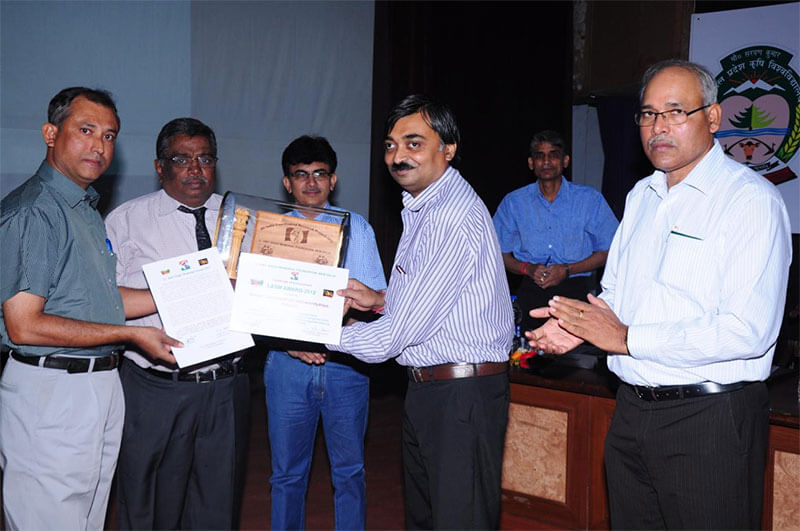
Scientists receiving Lt. Amit Singh Memorial Award for the best AICRP on Vegetable Crops centre in India from DDG (Horticulture) and ADG (Horticulture), ICAR, New Delhi.
Staffs
| Sl.No | Name | Designation | Date of Joining |
|---|---|---|---|
| 1 | Dr. Arup Chattopadhyay | Professor (Veg. Breeder) | 24.10.2005 |
| 2 | Dr. A.K.Mandal | Asstt. Professor (Jr. Virologist) | 04.09.2014 |
| 3 | Mr. B. Bhattacharya | Technical Assistant Gr. II | 01.04.1994 |
| 3 | Smt. Krishna Basu | Technical | 01.09.2008 |
Infrastructure
- Field facilities (area): Nearly one and half hectares
- Irrigation facilities and system of irrigation: Deep tube well, surface irrigation as well as drip irrigation
- Field laboratory facilities: Poly house, bacterial sick bed, oven, field balance and minor implements.
- Laboratory and office facilities: Oven, chemical balance, BOD incubator, Microscope, Laminar air flow, Digital Vernier calipers, Digital hand refractometer, RHS colour chart, Camera, LCD projector, Refrigerator, Desktop computer with printer and scanner, lap top computer etc.
Mandate / Objectives
- Collection, maintenance, evaluation and conservation of situation specific vegetable germplasm with special emphasis on value added germplasm.
- Development and improvement of vegetable varieties through breeding and selection.
- Disease resistance breeding by utilizing local sources of resistance through selection and evaluation of local germplasm and national entries against important vegetable diseases.
- Evaluation of national entries of Brinjal, Chilli, Tomato, Cowpea, Dolichos bean, Pumpkin, Ash gourd, and pointed gourd through field trial for yield and quality of vegetables.
- Screening of national entries of Brinjal, Okra and Tomato against Bacterial wilt, Yellow Vein Mosaic Virus and Tomato Leaf Curl Virus, respectively.
- Development of integrated disease management practices with minimum use of agrochemicals for sustainable production of vegetable crops.
Trials allocated/conducted during 2013-18
| Year | Trials allotted | Trials reported | Reporting (%) |
|---|---|---|---|
| 2017-2018 | 29 | 29 | 100.00 |
| 2016-2017 | 32 | 32 | 100.00 |
| 2015-2016 | 34 | 34 | 100.00 |
| 2014-2015 | 33 | 33 | 100.00 |
| 2013-2014 | 34 | 34 | 100.00 |
| Total | 162 | 162 | 100.00 |
Salient Findings
Conservation and characterization of germplasm
A large repository of vegetable germplasm have been maintained both through in situ and ex situ methods at C Block Farm under AICRP on Vegetable Crops, Kalyani, B.C.K.V. at present. A good number of genotypes having mutant genes in them have been assembled which is being used in different breeding programmes in the Viswavidyalaya. A brief account of special characteristics of germplasm is presented in Table-1 & 2.
Table-1. Characterization of vegetable germplasm
| Crop | Collections | Some important characters |
|---|---|---|
| Tomato | 105 | Anthocyanin absent, potato leaf, joint less pedicel, sporogenous male sterility, functional male sterility (non-dehiscent anther, exerted stigma), yellow fruit, deep green fruit, high pigment fruit, slow ripening, resistant to tomato leaf curl virus, tolerant to high temperature, very high bearing |
| Brinjal | 40 | Pigmentation, non-pigmentation, non-prickly, different flowering and fruiting pattern (solitary, cluster and mixed), very big fruit, less susceptible to shoot and fruit borer & bacterial wilt, less sensitive to high temperature, functional male sterility (non-dehiscence anther), etc. |
| Chilli | 60 | Purple and yellow corolla, bluish yellow and purple anther, very long, oval, conical and small fruit, erect fruit position, different blossom end characters, tolerant to leaf curl complex, high vitamin C content etc. |
| Pointed gourd | 32 | Female clones showing different fruit shape (spindle, oval, cylindrical), size and striation. |
| Spine gourd | 20 | Female clones showing different fruit shape (oval & cylindrical) & size; soft or tough spine etc. |
| Dolichos bean | 15 | Pole and bush type growth habit, pigmented and non pigmented vine, different pod colour (green, white, red), very high bearing, tolerant to mosaic etc. |
| Cowpea | 14 | Determinate and Indeterminate growth habit, pigmented and non pigmented vine, different pod colour (green, white, red), very high bearing, tolerant to cowpea mosaic virus etc. |
| Okra | 25 | Different plant structure, fruit length and colour and no. of ridges present on the fruits and tolerant to YVMV. |
| Cucumber | 15 | Different fruit shape (round, elongated oval, long, etc), tolerant to downy mildew |
Table-2. Mutant genotypes of tomato in the germplasm stock
| Gene symbol | Description of plant characters |
|---|---|
| aa | Anthocyanin absent, absence of anthocyanin in all plant parts |
| Aft | Anthocyanin fruit |
| dg | Dark green fruit and exaggerated photo-responsiveness |
| ful | Fulgens, chlorophyll B mutant |
| hp-1 | High pigment, high chlorophyll, carotenoids and ascorbic acid contents in fruit. |
| ogc | Old gold crimson, high lycopene and β-carotene contents in fruit |
| rin | Ripening inhibitor, delayed ripening and bright yellow fruit at maturity |
b. Evaluation of National entries
The centre has been conducted varietal trials on tomato, brinjal, chilli, cowpea, dolichos bean,pointed gourd ; hybrid trials on tomato (determinate and indeterminate) and chilli; resistant varietal trials on okra against YVMV, tomato against leaf curl virus and root knot nematode, brinjal against bacterial wilt during the last five years. A brief outcome on these trials is presented in Tables-3, 4, 5.
Table-3. Most promising OP varieties at the Gangetic alluvium of W.B.
| Crop | Name of the variety | Yield (q/ha) |
|---|---|---|
| Tomato (determinate) | DVRT-2; ATL-97-44 | 380-420 |
| Tomato (indeterminate) | Arka Vikas; BT-136 | 370-390 |
| Brinjal (long) | KS-331, PB-66 ; BCB-11, BCB-40 | 260-380 |
| Brinjal (round) | BCB-30, Swarna Mani, KS-224 | 250-340 |
| Chilli | BCC-1, BCCH Sel-4 | 90-120 |
| Cowpea | Kashi Kanchan; BCCP-3 | 120-170 |
| Dolichos bean | BCDB-1, KDB-413, JIB (V)-16 ;BCDB-2 | 303-470 |
| Pointed gourd | BCPG-3; BCPG-4; BCPG-5 | 500-600 |
Table-4. Most promising hybrids at the Gangetic alluvium of W.B.
| Crop | Name of the Hybrids | Yield (q/ha) |
|---|---|---|
| Tomato (determinate) | Ajeet-11; VNR-6A, BCTH-4, BCTH-62 | 550-750 |
| Tomato (indeterminate) | Himsona; Yashwant | 600-870 |
| Chilli | BSS-453; HH-2424 | 100-140 |
Table-5. Most promising resistant varieties at the Gangetic alluvium of W.B.
| Crop | Name of the tolerant varieties | Disease reaction* | Yield (q/ha) |
|---|---|---|---|
| YVMV of okra | NOH-303; Barkha; Kamini, BCO-1; VRO-6 | MR to R | 50-80 |
| Tomato leaf curl virus | BCTH-4; TLBRH-6, JKTH-3098 | MR to R | 550-700 |
| Root knot nematode of tomato | NDTTNR-76, NT-8 | MR to R | 330-350 |
| Bacterial wilt of brinjal | Arka Nidhi, BB-54, BCB-11, RCMBL-3, VNR-218 | MR | 170-220 |
*MR= Moderately resistant; R= Resistant
c. Utilization of germplasm and development of varieties and hybrids
Two varieties of vegetable cowpea (Bidhan Barbati-1 and Bidhan Barbati-2 ) under SVRC and one hybrid of tomato (BCTH-4) under CVRC have already been released long back.
i. Development of OP varieties under pipeline for release
We have so far been developed three varieties each of pointed gourd (BCPG-3, BCPG-4, BCPG-5) and Brinjal (BCB-11, BCB-30; BCB-40); two varieties each of Chilli (BCC-1, BCCH Sel-4) and one variety each of vegetable Cowpea (BCCP-3) and Dolichos bean (BCDB-1); one hybrid of tomato (BCTH-62) from indigenous germplasms assemblage and combination breeding and were tested under AICRP trials and recommended for release at SVRC. A brief description of varieties/hybrid is presented in Table-6.
Table-6: Brief description of OP varieties/hybrid which are in pipeline for release
| Name of the crop | Name of the line | Special characteristic features |
|---|---|---|
| Dolichos bean | BCDB-1 | Pole type dolichos bean selected from local germplasm assemblage and having dark green colour fleshy pod with purple suture, very high yielding (> 40 tonnes / ha) and tolerant to Bean Mosaic Virus. |
| Brinjal | BCB-11 | Selected from local germplasm assemblage. Plants with intermediate growth habit; oblong fruit shape with green colour with purple tinge and having green calyx; fruiting pattern-solitary; fruit length 18.00 cm; fruit girth : 6.50 cm; average fruit weight : 300g; average fruit yield is 320 q/ha and moderately tolerant to bacterial wilt disease. |
| BCB-30 | Selected from local germplasm assemblage. Plant having somewhat erect growth habit; round fruit shape with blakish purple colour. Fruiting pattern-solitary; fruit length 16.00 cm; fruit girth : 10.30 cm; average fruit weight : 240g; average fruit yield is 300 q/ha | |
| BCB-40 | Developed through combination breeding; Plants with prostrate growth habit; oblong fruit shape with purple colour and having green-purple calyx; fruiting pattern-solitary; fruit length 20.00 cm; fruit girth : 7.50 cm; average fruit weight : 280g; average fruit yield is 350 q/ha. | |
| Chilli | BCC-1 | Selected from local germplasm assemblage. Plants having intermediate growth habit; immature fruit colour- green; ripe fruit colour- orange red; fruit shape- conical; fruit position- erect; fruit length : 4.25 cm; fruit width : 1.20cm; average fruit weight : 3.0 g; highly pungent; average green fruit yield is 50.0 q/ha. |
| BCCH Sel-4 | Selected from local germplasm assemblage. Plants having intermediate growth habit; immature fruit colour- green; ripe fruit colour- red; fruit shape- long; fruit position- pendant; fruit length : 6.20 cm; fruit width : 1.20cm; average fruit weight : 1.65 g; highly pungent; average green fruit yield is 65.0 q/ha. | |
| Cowpea | BCCP-3 | Developed from combination breeding. Plants having determinate growth habit, very early flowering, dark green pod. Pod length-26.0 cm, pod weight-11.0 g with average pod yield is 140 q/ha. Suitable for growing in spring-summer and rainy season. Tolerant to Cercospora leaf spot. |
| Pointed gourd | BCPG-3 | This is clonal selection of pointed gourd. Early plant vigour good and medium viny in nature. Stem shape angular, tendril branched and coiled. Leaves serrated round and medium in size (6.5-7cm), pubescent, intermediate and sparse. Petiole length (3.5-5cm),fruit spindle shaped, medium curved fruit skin primary color light green with white alternate stripe. Average fruit length 7.30 cm, girth 3.5 cm. fruit weight 34.0 g. Average yield 620 q/ ha. |
| BCPG-4 | This is a clonal selection of pointed gourd. Early plant vigour good and medium viny in nature. Stem shape angular and pubescent, tendril branched and coiled. Leaves serrated oblong and medium in size (7.5-8cm), pubescent, intermediate and sparse. Petiole length (3.5-5cm), fruit spindle shaped, fruit skin primary color dark green with white alternate stripe having rough skin. Average fruit length 8.78 cm, girth 3.52 cm. fruit weight 44.0 g. Average yield 600 q/ ha. | |
| BCPG-5 | This is a clonal selection of pointed gourd. Early plant vigour good and medium viny in nature. Stem shape angular and pubescent, tendril branched and coiled. Leaves serrated oblong and medium in size (8-9cm), pubescent, intermediate and sparse. Petiole length (4.0-5.0cm), fruit long shaped, fruit skin primary color dark green with prominent white alternate stripe having smooth skin. Average fruit length 9.50 cm, girth 3.75 cm. fruit weight 46.0 g. Average yield 580 q/ ha. | |
| Tomato (Hybrid) | BCTH-62 | This is a highly pigmented big fruited tomato hybrid with slow ripening character. Semi-determinate in growth habit with partly biparous cyme. Fruits are oblong-heart shaped, deep red, 106 g in weight with 3-4 locules, 0.59 cm pericarp thickness, TSS 4.24o Brix and acidity 0.60 percent. Suitable for processing. Average yield is 55 t/ha under autumn-winter season in West Bengal. |
| Okra | BCO-1 | This has been developed through single plant selection of okra from combination breeding of Abelmoschus esculentus and Abelmoschus manihot, which is characterized by short plant stature, medium long (9.5cm) green pods having yield potentiality of 80-85 q/ha and highly resistant to YVMV disease. |
ii. Development of promising trait-specific hybrids
We have identified some trait specific hybrid combinations by utilization of diverse indigenous and exotic genotypes to develop following commercially utilizable hybrids.
| Crop | Hybrid combinations | Specific traits | Documented in Journals |
|---|---|---|---|
| Okra | VNR Green × Shagun | High yield, highly tolerant to YVMV disease | International Journal of Vegetable Science 19 (1):2013 |
| Barsha Laxmi × Parbhani Kranti | |||
| Tomato | CLN 2777 F × CLN 2777 E CLN 2777E × Ailsa Craig fulgens | High yield and highly tolerant to ToLCV & Early blight diseases | New Zealand Journal of Crops and Horticultural Sciences, 43 (4): 2015 |
| Chilli | BCCH Sel-4 × AC-575 | High yield and highly tolerant to PepLCV disease | Scientia Horticulturae, 182: 2015 |
Recommendations at State/National levels (Vegetable Protection Technologies)
- Soil application of green manuring + neem cake @ 5q/ha, and seed and soil treatment with bioagents (Trichoderma [email protected] kg/ha) are effective for the management of Root and collar rot of okra.
- Leaf wetness duration (8-12 hrs. of leaf wet duration) and average temperature (18-220 C) were identified as major climatological factors for the development of Downy mildew disease of cucumber.
- Border crop with maize (25 days before sowing of okra) followed by seed treatment with Imidacloprid and four spraying alternatively with Acephate (1.5g/l) + neem oil , Imidacloprid (0.5 ml/l) + neem oil, Admire (Imidacloprid 70% WG) @ 2 g/15l + neem oil and Hostathion (1 ml/l) + neem oil at the interval of 10 days starting from 20 days after sowing of okra was found to be effective considering yield, YVMV disease severity and economic points of view.
- Spraying of Propiconazole @ 1 ml/l at the initiation of Cercospora leaf spot disease of cowpea at 10 days interval for two times was found to be effective considering yield, disease severity and economic points of view.
- Maximum temperature (28-320C) and average RH above 80% was found to be conducive for population build up of whitefly and severity of YVMV disease of okra. Minimum RH and minimum temperature were found to be the most important predictor for Forewarning of YVMV disease severity of okra. R. solanacearum of brinjal isolates of WB belongs to Race-1 and Biovar-III.
- Seed treatment with metalaxyl-mancozeb(0.25%) and two need based spray with fosetyl-Al(0.25%) or cymoxanil-mancozeb(0.25%) at 10--15 days interval for economic management of downy mildew disease of cucumber.
- Border crop with maize (30 days before transplanting of tomato and chilli) followed by covering of the nursery bed with 40-60 mesh fine nylon net and spray the seedlings with Imidacloprid (3.5 ml / 10lt) and laying of agri-silver mulch followed by 3 foliar sprays with Imidachlorpid (3.5 ml/10l)or Acetameprid (0.25g/l) or Thiomethoxam(.3g/l) at 10 days interval and alternate the spray schedule with NSKE (0.5%) was found effective considering yield, leaf curl virus disease severity and economic point of view of tomato and chilli.
Special not covered in above
- Prospective technologies imparted to the farmers
- Production of genetically pure seeds of improved varieties of different vegetables.
- Providing support for plant protection measures against different biotic stresses of vegetables.
- Post harvest handling operations and storage of vegetables
- Breeder seed production & distribution
A small amount of seeds/planting materials of some improved varieties/hybrids (Bidhan Barbati-1, Bidhan Barbati-2, BCCP-3 of cowpea; BCB-11, BCB-30, BCB-40 of brinjal; BCC-1 and BCCH Sl-4 of chilli; BCDB-1 of dolichos bean; BCO-1of okra; and BCPG-3, BCPG-4, BCPG-5 of pointed gourd) are being produced and distributed among the farmers in regular manner. - Service to the farmers
- Imparting training to the farmers, organizing field day, delivering lectures in TV programmes, selection of varieties through farmers’ participatory mode are some of the activities of the project.
- Regular contact with the farmers through Toll Free line Plant Health Clinic.
- Indian Council of Agricultural research, New Delhi has launched Tribal Sub Plan project during XII Plan Period for the overall economic development of ST farmers of the country. AICRP on Vegetable Crops, Kalyani centre has been entrusted to such project on Food and nutritional security of tribal through vegetable farming during 2013-14 and operated in two districts (Burdwan and Birbhum) of West Bengal facilitating more than 400 tribal farmers.
Achievements
Publications (2013-18)
- Books (UG & PG standard) : Two
- Books (Regional language): Two
- Book chapter: Two
- Extension bulletin/Training manual: Five
- Leaflets: Thirty (Both in English & Bengali)
- Research papers published in National refereed journal: Twenty five
- Research papers in International refereed journal: Twenty two
- Ten Research papers have NAAS rating between 6.0 & 6.5
- Two Research papers have NAAS rating between 6.5 & 7.0
- Three Research papers have NAAS rating > 7.5
Adhoc Research projects handled by the scientists (2013-18)
- i. Isolation of mutant with exerted stigma and anther non-dehiscence characters in PS-2 functional male sterile line of tomato for utilization in hybrid seed production funded by Bhava Atomic Research Centre, Trombay, Mumbai (Completed).
- NICRA project on Real Time Pest Surveillance on Tomato funded by the ICAR, New Delhi (On-going).
- DUS testing on pointed gourd funded by PPV & FR Authority (On-Going).
- Food and nutritional security of tribal farmers through vegetable farming funded by the ICAR, New Delhi (On-Going).
- Enhancement of nutritional quality of tomato by increasing lycopene and anthocyanin contents through mutant genes funded by DST, GOI (On-going)
- Agri-Biodiversity, Management and use of PGR-Component-II-Evaluation and use in prioritized crops-Okra funded by the ICAR, New Delhi (Completed).
- Development and validation of grafted seedlings of brinjal for the management of bacterial wilt disease funded by SERB, GOI (On-going).
Recognition received by the scientists at National level
- Received Lt. Amit Singh Memorial Award for the best AICRP on Vegetable Crops centre in India conferred by the ICAR, New Delhi during 2012-13.
- Received the Best poster Awards in different National seminars on held at IGKV, Raipur during 2013, held at BCKV, Kalyani during 2015, held at IIVR, Varanasi during 2016
- Scientists acted as National Presenters in Crop improvement and Disease Management Sessions in Annual Group Meet of the project for the last couple of years.
- Scientists recognized as Fellows in CWSS, BCKV & ISVS, Varanasi
Integrated management of YVMV, ToLCV, PepLCV diseases

